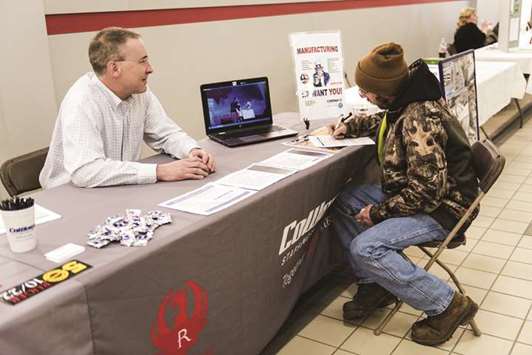The number of Americans filing for unemployment benefits fell to a near 45-year low last week, pointing to strong job growth in February and solid momentum in the economy.
The economy’s brightening prospects were also underscored by other data yesterday showing a gauge of future economic activity increasing for a fourth straight month in January.
labour market strength should continue to underpin consumer spending, despite a drop in retail sales in January.
“Firms are extraordinarily unwilling to part company with workers reflecting, in all likelihood, the difficulty of replacing them,” said John Ryding, chief economist at RDQ Economics in New York.
Initial claims for state unemployment benefits dropped 7,000 to a seasonally adjusted 222,000 for the week ended February 17, the Labour Department said yesterday.
Claims fell to 216,000 in mid-January, which was the lowest level since January 1973.
Claims for six states, including California, were estimated because of Monday’s Presidents Day holiday.
While that probably distorted last week’s data, the underlying trend in claims was consistent with a robust labour market.
Economists polled by Reuters had forecast claims unchanged at 230,000 in the latest week.
It was the 155th straight week that claims remained below the 300,000 threshold, which is associated with a strong labour market.
That is the longest such stretch since 1970, when the labour market was much smaller.
The labour market is near full employment, with the jobless rate at a 17-year low of 4.1%. Tightening labour market conditions are starting to push up wage growth, which could help to lift inflation toward the Federal Reserve 2% target.
Minutes of the US central bank’s January 30-31 policy meeting published on Wednesday showed policymakers upbeat in their assessment of the economy and a number “judged that the continued tightening in labour markets was likely to translate into faster wage increases at some point.”
The minutes also noted that “several others suggested that the upside risks to the near-term outlook for economic activity may have increased.”
The dollar was trading lower against a basket of currencies.
Prices for US Treasuries rose, with the yield on the benchmark 10-year note retreating from a more than four-year high. Stocks on Wall Street rose after two days of losses.
The Labour Department said claims for California, Hawaii, Maine, Virginia, West Virginia and Wyoming were estimated.
It also said claims-taking procedures in Puerto Rico and the Virgin Islands had still not returned to normal, months after the territories were slammed by Hurricanes Irma and Maria.
The four-week moving average of initial claims, considered a better measure of labour market trends as it irons out week-to-week volatility, fell 2,250 to 226,000 last week.
The claims data covered the survey period for the non-farm payrolls component of February’s employment report.
The four-week average of claims dropped 17,500 between the January and February survey weeks, suggesting solid job growth this month.
“With upbeat readings coming out of the initial claims data, we think job growth will likely be strong again in February,” said Daniel Silver, an economist at JPMorgan in New York.
Payrolls increased by 200,000 jobs in January.
Strong employment gains in February would seal the case for an interest rate increase next month.
The Fed has forecast three rate increases this year.
Most economists, however, expect four rate hikes in the wake of strong inflation readings in January.
The claims report also showed the number of people receiving benefits after an initial week of aid declined 73,000 to 1.88mn in the week ended February 10.
The four-week moving average of the so-called continuing claims fell 16,250 to 1.93mn.
In a separate report on Thursday, the Conference Board said its Leading Economic Index jumped 1.0% in January after increasing 0.6% in December.
The surge in the LEI reflected strong financial conditions, manufacturing, home building and labour markets.
“The US LEI accelerated further in January and continues to point to robust economic growth in the first half of 2018,” said Ataman Ozyildirim, director of business cycles and growth research at the Conference Board.

A job seeker (right) fills out an application at a resource fair in Belmont, New Hampshire (file). Initial claims for state unemployment benefits dropped 7,000 to a seasonally adjusted 222,000 for the week ended February 17, the Labour Department said yesterday.
